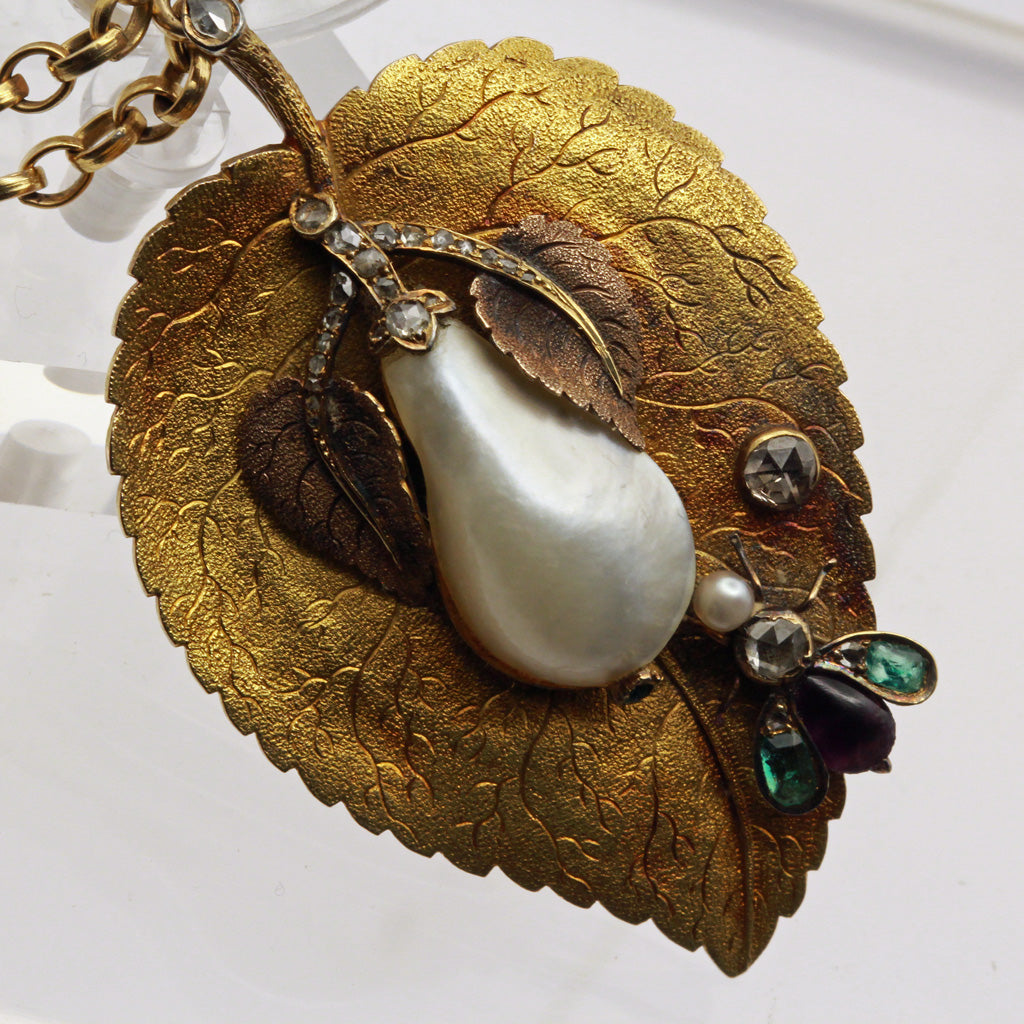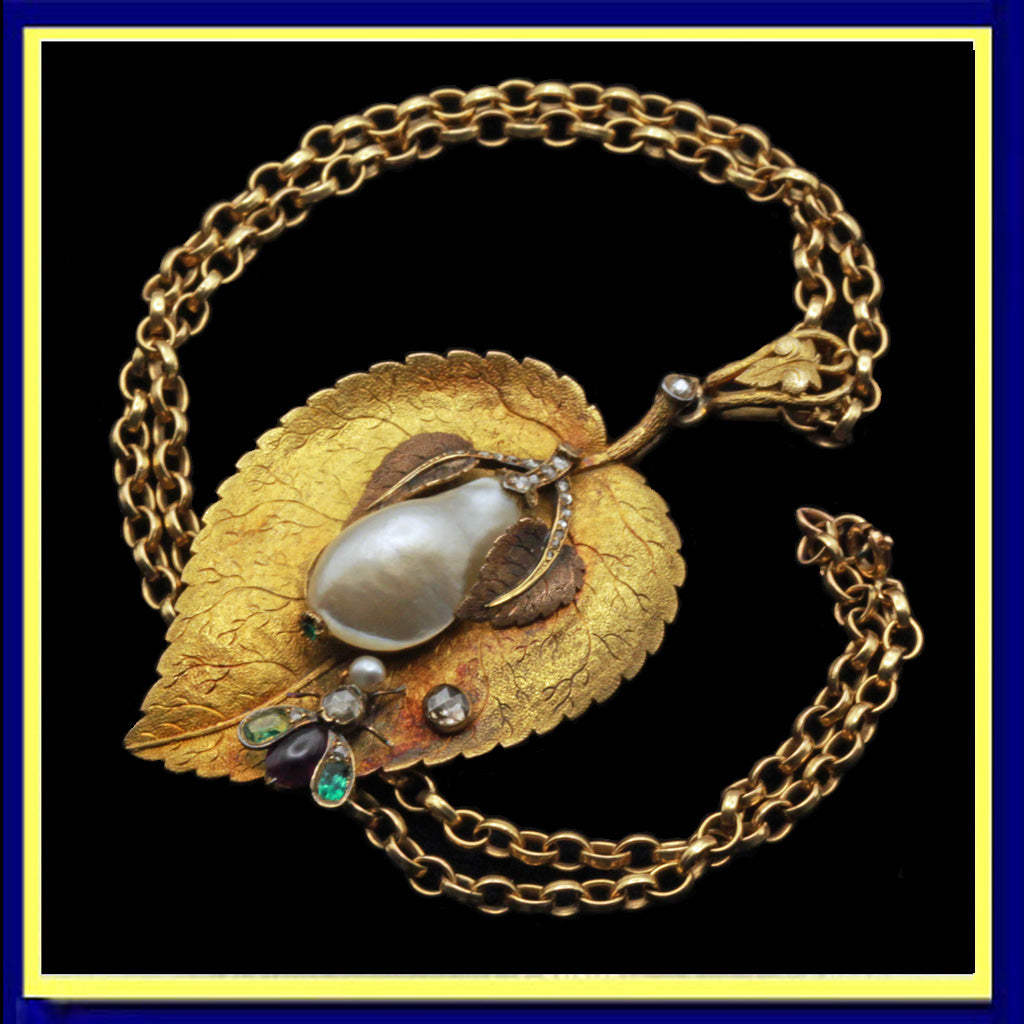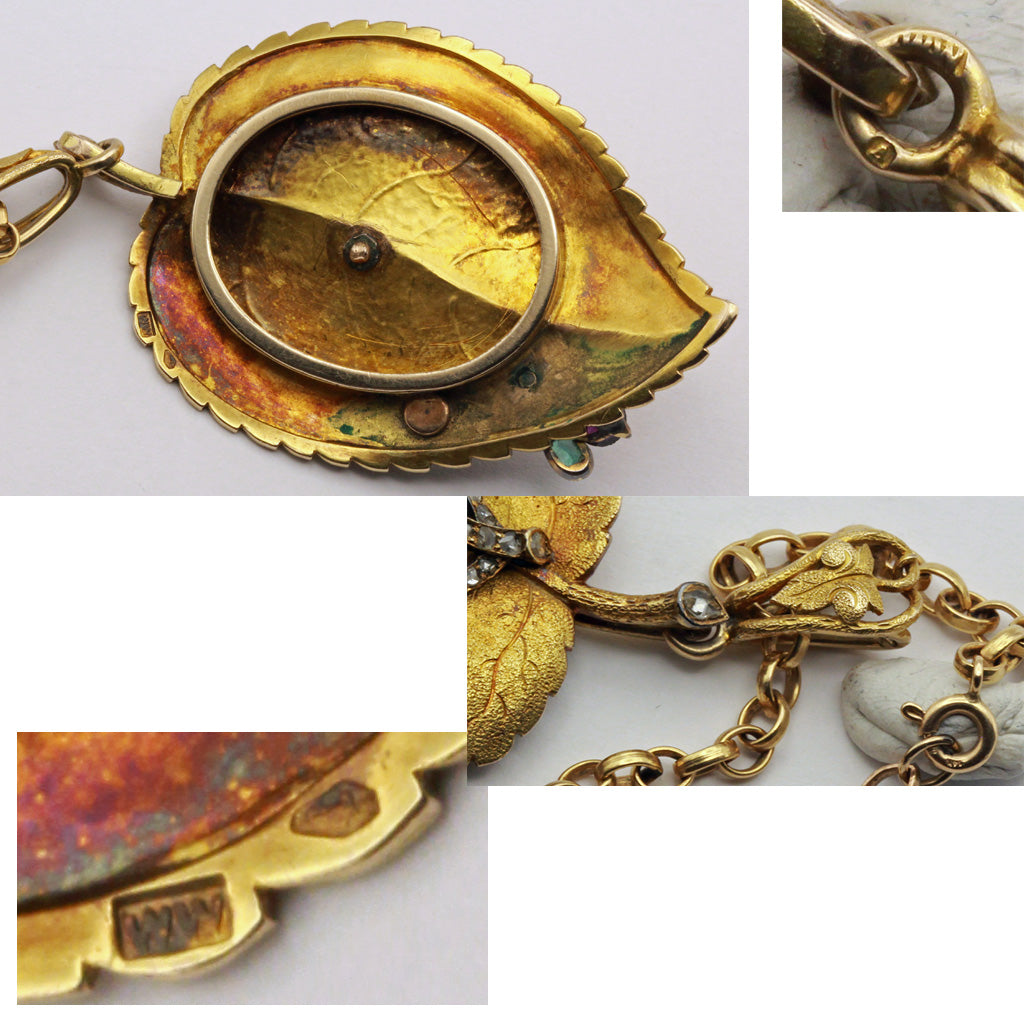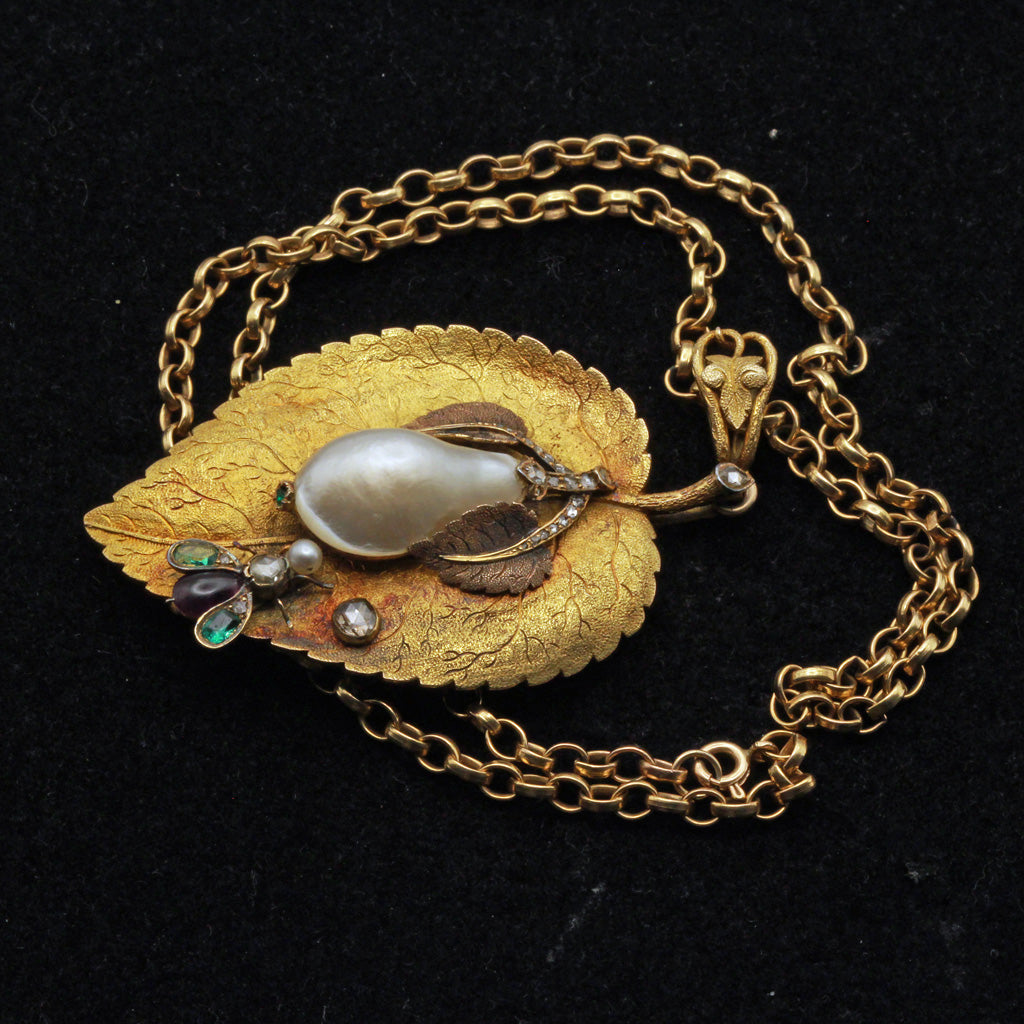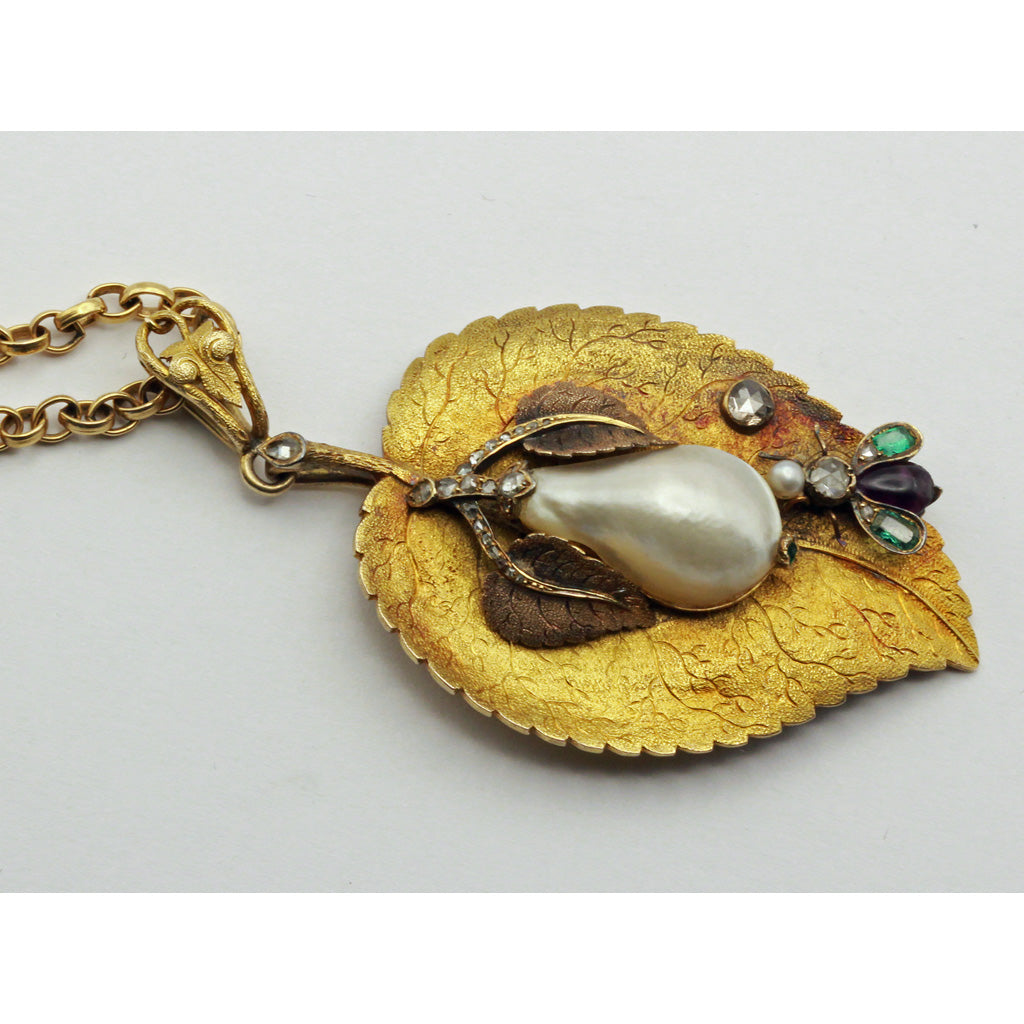Brenda Ginsberg Antique Jewelry
Antique Pendant chain Necklace Gold Pearl diamonds fruit fly Wilhelm Weiss (7387)
Antique Pendant chain Necklace Gold Pearl diamonds fruit fly Wilhelm Weiss (7387)
Regular price
$4,250.00 USD
Regular price
Sale price
$4,250.00 USD
Unit price
per
Couldn't load pickup availability
Antique Art Nouveau Vienna Secessionist chain necklace and pendant. 14k yellow and red gold, pearl, diamonds, emeralds and amethyst. Made in Vienna, Austria by Wilhelm Weiss, late 19th - early 20th century. (circa 1897-1910).
At the time Vienna was the capital of the Austia-Hungarian empire.
Measurements: Weight is 28.6 grams. Chain is 17.5 inches (44.5cm) long. Length of pendant from bale to tip is 2 3/4 inches (7.2cm).
Description : Wonderful novelty pendant featuring a little story with a lesson in the form of a fruit, flies and foliage. On a great old chain, almost certainly original to one another.
Starting at the top:
The chain is beautifully made of broad interlocking oval loops and is very sturdy.
The bale matches the pendant perfectly and echoes the foliate and botanical theme. The pear shape of the bale is formed by textured gold stems, gently overlapping one another and folding down to a grape leaf in the center.
The pendant attaches to the bale via a long, strong and sturdy hook - easily placed or removed behind the leaf and quite secure once attached.
This loop folds over itself to form a twig or stem. A small pear-shaped diamond is placed at the top of the twig. This realistic stem supports a large, almost heart-shaped leaf with serrated edges (in yellow gold). The entire surface of the leaf is textured and engraved naturalistically to resemble a real leaf.
In the center is a large pear, formed from a natural pearl. Unusually large in size and with lovely patina that reflects light and gleams more even than the surrounding diamonds. The calyx and tri-lobed stems are also pave set with diamonds. On either side of the pear is a fully 3-dimentional gold leaf - red gold smaller leaves on the large leaf background. This pair quietly and gently enclose the pear-shaped pearl, which terminates in another, collette-set emerald.
Below the fruit is a fly about to consume the fruit. The image of fruit and fly very cute. The fly is composed of gems: pearl, diamond, emeralds and cabochon amethyst. There are most likely multiple meanings and significance of the fruit and the fly, from pure fun and hedonism to that of our mortality and the impermanence of the body, which in turn links to religious themes for those so inclined.
A drop of dew is composed of a diamond in a gold collette setting and placed between the pear and the fly.
The back has a reserve, bordered in gold (detachable) that was clearly meant to hold a portrait or lock of hair. The glass that covered this is currently missing, but easily replaceable if so desired.
Wilhelm Weiss was a member of the Vienna Secessionist movement, parallel in time, style and theory to the Art Nouveau movement in France. The Victorians had a great sense of humour and this is sometimes reflected in quirky jewelry, which makes us smile and is so much more fun than the sum of its parts. Great conversation pieces like this with fantastic workmanship are rare and a wonderful addition to any collection.
The large size and strong design makes this suitable to wear by a man or a woman.
Marks and Metal: The loop at the bottom of the bale has an Austro-Hungarian mark - a fox facing left for 14k gold, as well as WW (all somewhat worn). The same Austrian mark and WW are found more clearly behind the serrated edges of the leaf. The fox mark with slight variations was used in Austro-Hungary between 1867 and 1922.
14k marked on the jump loop of the chain.
Condition: Good with negligible wear commensurate with age. Missing locket glass mentioned above. Please see enlarged pictures and don't hesitate to ask questions which we will do our best to answer.
The Story: It is so tantalising to consider what very special women originally owned this unique and novel piece of beautifully made jewelry. Given the date of it's manufacture, we can guess that it has passed through the hands of close on half a dozen women, each one in her turn living through history from the 19th to the 21st centuries, each one with her own story. When it was bought, the necklace was an extremely bold statement. In 19th century Austria, women had a clearly subservient rold to their menfolk. Their options were proscribed and they had almost no rights. Yet, here was a woman who was given a large, bold pendant necklace, reflecting a strong, quirky and humourous character. A women who did have thoughts of her own and whose husband appreciated her all the more for that. These people were innovators. They did not stick to the classic formalism of most jewelry of the time. They had the means, education and guts to look for new alternatives and to create and support a new world of Arts and Crafts as opposed to the mundane and sickly sweet. No doubt, the original owner of this necklace was a strong women, working, perhaps behind the scenes, but side by side with her husband and clearly they had the means to buy a costly, unique and handmade item.
The 20th century was riddled with conflict and many European people uprooted themselves, whether willingly or not. As a result, much old European jewelry landed up right here in the USA, where we have been lucky enough to find and acquire it. Clearly time for a new very special owner to enjoy this fabulous piece of real history. A work that says so much more than what is on the surface, that makes you smile and delight in the beautiful workmanship and materials.
View full details
At the time Vienna was the capital of the Austia-Hungarian empire.
Measurements: Weight is 28.6 grams. Chain is 17.5 inches (44.5cm) long. Length of pendant from bale to tip is 2 3/4 inches (7.2cm).
Description : Wonderful novelty pendant featuring a little story with a lesson in the form of a fruit, flies and foliage. On a great old chain, almost certainly original to one another.
Starting at the top:
The chain is beautifully made of broad interlocking oval loops and is very sturdy.
The bale matches the pendant perfectly and echoes the foliate and botanical theme. The pear shape of the bale is formed by textured gold stems, gently overlapping one another and folding down to a grape leaf in the center.
The pendant attaches to the bale via a long, strong and sturdy hook - easily placed or removed behind the leaf and quite secure once attached.
This loop folds over itself to form a twig or stem. A small pear-shaped diamond is placed at the top of the twig. This realistic stem supports a large, almost heart-shaped leaf with serrated edges (in yellow gold). The entire surface of the leaf is textured and engraved naturalistically to resemble a real leaf.
In the center is a large pear, formed from a natural pearl. Unusually large in size and with lovely patina that reflects light and gleams more even than the surrounding diamonds. The calyx and tri-lobed stems are also pave set with diamonds. On either side of the pear is a fully 3-dimentional gold leaf - red gold smaller leaves on the large leaf background. This pair quietly and gently enclose the pear-shaped pearl, which terminates in another, collette-set emerald.
Below the fruit is a fly about to consume the fruit. The image of fruit and fly very cute. The fly is composed of gems: pearl, diamond, emeralds and cabochon amethyst. There are most likely multiple meanings and significance of the fruit and the fly, from pure fun and hedonism to that of our mortality and the impermanence of the body, which in turn links to religious themes for those so inclined.
A drop of dew is composed of a diamond in a gold collette setting and placed between the pear and the fly.
The back has a reserve, bordered in gold (detachable) that was clearly meant to hold a portrait or lock of hair. The glass that covered this is currently missing, but easily replaceable if so desired.
Wilhelm Weiss was a member of the Vienna Secessionist movement, parallel in time, style and theory to the Art Nouveau movement in France. The Victorians had a great sense of humour and this is sometimes reflected in quirky jewelry, which makes us smile and is so much more fun than the sum of its parts. Great conversation pieces like this with fantastic workmanship are rare and a wonderful addition to any collection.
The large size and strong design makes this suitable to wear by a man or a woman.
Marks and Metal: The loop at the bottom of the bale has an Austro-Hungarian mark - a fox facing left for 14k gold, as well as WW (all somewhat worn). The same Austrian mark and WW are found more clearly behind the serrated edges of the leaf. The fox mark with slight variations was used in Austro-Hungary between 1867 and 1922.
14k marked on the jump loop of the chain.
Condition: Good with negligible wear commensurate with age. Missing locket glass mentioned above. Please see enlarged pictures and don't hesitate to ask questions which we will do our best to answer.
The Story: It is so tantalising to consider what very special women originally owned this unique and novel piece of beautifully made jewelry. Given the date of it's manufacture, we can guess that it has passed through the hands of close on half a dozen women, each one in her turn living through history from the 19th to the 21st centuries, each one with her own story. When it was bought, the necklace was an extremely bold statement. In 19th century Austria, women had a clearly subservient rold to their menfolk. Their options were proscribed and they had almost no rights. Yet, here was a woman who was given a large, bold pendant necklace, reflecting a strong, quirky and humourous character. A women who did have thoughts of her own and whose husband appreciated her all the more for that. These people were innovators. They did not stick to the classic formalism of most jewelry of the time. They had the means, education and guts to look for new alternatives and to create and support a new world of Arts and Crafts as opposed to the mundane and sickly sweet. No doubt, the original owner of this necklace was a strong women, working, perhaps behind the scenes, but side by side with her husband and clearly they had the means to buy a costly, unique and handmade item.
The 20th century was riddled with conflict and many European people uprooted themselves, whether willingly or not. As a result, much old European jewelry landed up right here in the USA, where we have been lucky enough to find and acquire it. Clearly time for a new very special owner to enjoy this fabulous piece of real history. A work that says so much more than what is on the surface, that makes you smile and delight in the beautiful workmanship and materials.


